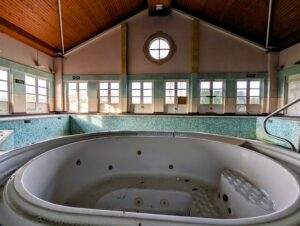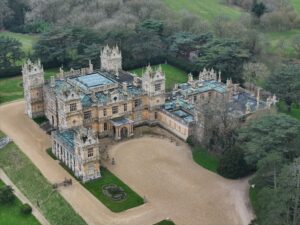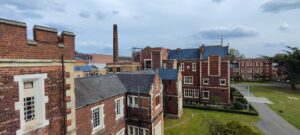Abandoned Hampshire: NGTE Pyestock Water Treatment Plant- Farnborough | Urbex

It’s the end of a day of successful Urbexing, we have two locations left and enough time to explore one. One looks risky, the other looks safe. Which would you do?
We chose the risky one.
But first, some background before we dive into today’s explore: In one of our all time favourite explores, we explored the Pyestock Anechoic Chamber. The cavernous facility was truly one of the all time great explores for us as a group, only made sweeter by the fact the entire area, along with the building, was razed to make way for property development the very week after we visited. We were some of the last urban explorers to step foot in the building before its ultimate destruction.
In the surrounding areas of the former facility, some critical infrastructure that was link to the site has remained- this ghostly infrastructure is what we wanted to explore today.
The National Gas Turbine Establishment, also known as Pyestock, was a jet engine and gas turbine testing facility that saw extensive use during the cold war. It opened in the 1940s and was expanded until its closure in 2000. From the 1950s to the 1970s it was the largest facility of its kind in Europe. The V bomber, Harrier and Tornado engines were tested on the vast site. Captured Soviet engines were also examined on the premises.
We delved extensively into the sites history in the entry of our other explore, which can be read here. But for today, the main thing to note about this site was that it employed over 1,000 people at any one time and due to the secretive nature of the work carried out there, the site had to be VERY self-sufficient, this included water treatment.




We had no idea at the time, but the site we were about to explore was the water treatment plant for the former site.
The test plant and equipment produced a large amount of waste water, which was treated at this facility off to the east of the main facility- waste water and contaminated water was pumped to this site for treatment and disposal
To start, drainage water from the main testing facility was pumped through to this site, first arriving in a massive storm tank, also called a balance tank. This was basically a giant concrete pool with a capacity of 750,000 gallons of water, which is more than an Olympic pool.
The water would then be treated and oils, toxic material and other contaminants would be removed from the water. The contaminated water would then be pumped into two ‘dwell’ tanks sat near the storm tanks. Other oily fluids from Pyestock would be pumped into these ‘dwell’ tanks via an elevated pipeline. These tanks would allow the waste to settle before it was then pumped into a significantly larger settling tank, with a capacity of a million gallons of water, for additional processing.
Once the water was processed, clean water could re-enter the environment while contaminated water would be removed for disposal.
This all sounds quite complex, but Section 5.6 of this website provides all the information for the water treatment site. It has photos from the time, map diagrams and clearly shows how everything worked together in a much clearer manner than my description above.
The main thing to know is: Around the turn of the Millennium, the site shut down and the water treatment plant became completely overgrown by 2018, yet it was all cleared by 2020 as the testing site was bulldozed and re-development began. The main site has been destroyed, but the water treatment site remains the final physical link to the incredible site that it served.




Exploring The Pyestock Water Treatment Plant
As we wandered through the woods, we found our access point, emerging at the edge of the enormous storm tank. The water inside the enormous concrete pool was at a very low level and was milky grey from years of neglect. We carefully traversed the edge before finding an open gate, beckoning us deeper into the facility. We went through and the large open land of the site lay ahead of us.
Before us, the pipeline that funnelled water from Pyestock reached from right to left. A short distance to our left were the smaller dwell tanks that the pipe was leading to, as well as the larger million gallon settling tank. Just behind the pipeline that arched over our path like an entrance gateway, was a smaller tank, similar in size to the dwell tanks on our left. Curiously, I noticed a sign, we evidently weren’t the first explorers and we certainly won’t be the last. The sign, written by the landowners, had a very clear message to stay out and any trespassers would be arrested. Almost as if to enforce the sign, attached to the pipe was an active CCTV camera. ‘Guys’ I called, ‘Camera.’ The group saw it, to which one said: ‘We don’t have much time, let’s get our shots and leave.’






We passed under the pipeline and looked at the massive pile of rubble to our right. I would later learn that this former building was the sooty water treatment facility. A physical building for extra processing of dirty water after the water had passed through all the tanks. The building didn’t exist anymore but the small settling tank next to the building still remained. Interestingly, a series of small self contained green tanks sat atop the buildings rubble and you can see similar looking tanks in an old picture in the link posted above. It makes me wonder the function of these tanks, but if I had to guess, I would say storage of water that needed to be disposed of off-site.
We inched our way over the overgrown land to the million gallon settling tank. We now had two ways we could go: Around to the left of the tank were two smaller steel ‘dwell’ tanks, to the right of the million gallon tank appeared to be a small block house. One of the team headed left and over to the ‘dwell’ tanks. With our time likely limited, I decided to take a risk and head off on my own to the block house on my right.






The ground around the block house was mostly overgrown concrete, with a several raised mounds to protect the house. With the variable terrain and holes in the concrete exposing different valves and machinery, I had to watch where my feet went otherwise my foot would shoot into the earth and I could break something.
As I approached the building, I noticed a additional cameras and contemplated how little time we had to capture what we could on this site. One of the team came across and joined me, I informed them of the security measures and we ploughed on with the explore.
I glanced in a lower window in the blockhouse wall and was greeted with the sight of a semi-flooded basement, full of rusted motors attached to water pipes. Looking at the diagram of the site and the way water flowed, this blockhouse was clearly a control room for where the water would be directed, it could be re-cycled through the process, it could be pumped into the environment, it could be pumped to the sooty water treatment facility, this small inconspicuous house was where all that water flow was controlled from. I prepared to hop up to look in the higher level of the blockhouse when my friend snapped: ‘security!’





I didn’t see anything right away but instinctively hit the floor and started briskly making my way with my friends back the way we came, we all stuck together and before long, the full group was huddled together, keeping our heads low and darting across the derelict site. I chanced a glance back and there they were, a few high viz jackets, hot on our heels.
‘They still behind us?’‘Yup’ ‘Stop!’ Came a call in the distance.
I scoffed under my breath, we were leaving and we were leaving NOW.




With security closing the gap, we shimmied around the storm tank that greeted us when we first entered the site and made our way back to our entry point. With all of us successfully out and ok, we disappeared into the woods. I chanced one final look back to see the high vis jackets, stood by the fence, eyes watching us like hawks as we escaped their jurisdiction.
During our explore all of us were a bit mystified about the site, it’s nature, function and purpose, as we hadn’t done any prior research. However, we all loved this explore. It was simple and short but absolutely beautiful, with the added thrill of being chased off site too. We all agree that for an explore that was cut extremely short, we had an absolute blast.



Last Updated on 20 January 2025 by Michael




